FINDING YOUR BROWNSTONE – IN 1924
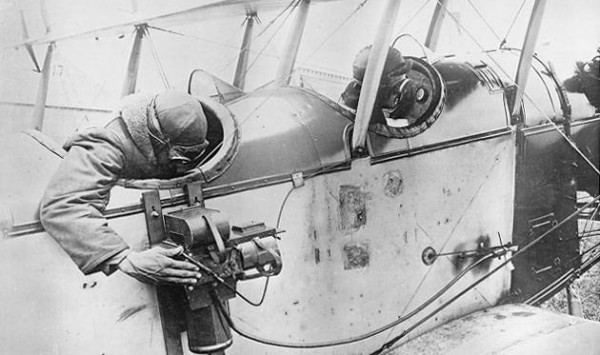
******************************************************************************************************************************** Brownstone Detectives investigates the history of our clients’ homes. The story you are about to read was composed from research conducted in the course of one of those investigations. Do you know the history of YOUR house? ******************************************************************************************************************************** Have you ever wondered what your neighborhood looked like in 1924? Or 1951? Or 1996? Aerial photography exists of all of New York City’s neighborhoods and is available to view (and zoom in on!) for free just by visiting NYC Map (a service of the City of New York). Simply type your address in the box at the top of the page and click “Search.” Then – in the upper right hand corner of the map – click on “Map Type,” and select the year you would like to view. Here is a view of Stuyvesant East in Bedford-Stuyvesant (showing Saratoga Park) in 1924. As you might have guessed, you won’t be able to see the expressions on peoples’ faces with this imagery, but it will give you a good indication of what your neighborhood looked like in any of these years. For comparison’s sake, here is a view of the same section of Bedford-Stuyvesant (as above) – but for 1996. What differences do you note between the two pictures? Comparing the two maps, you can see some obvious changes. Other than the fact that the second image is in color and was apparently taken in the winter time, if you look closely, you can see how whole swaths of brownstones […]
HALLOWEEN ON THE SUBWAY (1922)
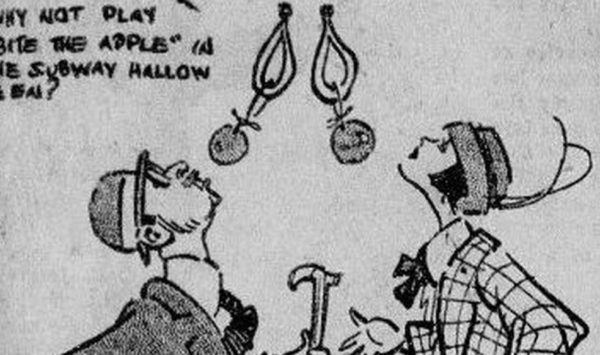
******************************************************************************************************************************** Brownstone Detectives investigates the history of our clients’ homes. The story you are about to read was composed from research conducted in the course of one of those investigations. Do you know the history of YOUR house? ******************************************************************************************************************************** Those of you who live in New York might have seen costumers on the subway during your commute today. It is less likely, though, that you saw straphangers bobbing for apples. At the time of this cartoon’s publication in the October 29th, 1922 edition of the New York Tribune, the subway was a mere 18-year-old. And the term “straphanger” was not much older – it derived from the (at first leather, and later metal) straps which hung from the ceiling of a street or subway car. “Why not play ‘bite the apple’ in the subway Halloween?”, shows two New Yorkers, a “dudish” man and an “artsy” woman (two typical subway riders of the day?) “bobbing” for apples from those straps. When was the last time you played this game??? Follow @BrownstoneDetec Share ———————————————————————————————————————– The Brownstone Detectives Brownstone Detectives is an historic property research agency. Our mission is to document and save the histories of our clients’ homes. From our research, we produce our celebrated House History Books and House History Reports. Contact us today to begin discovering the history of your home.
A TREE FALLS ON PROSPECT PLACE (1901)
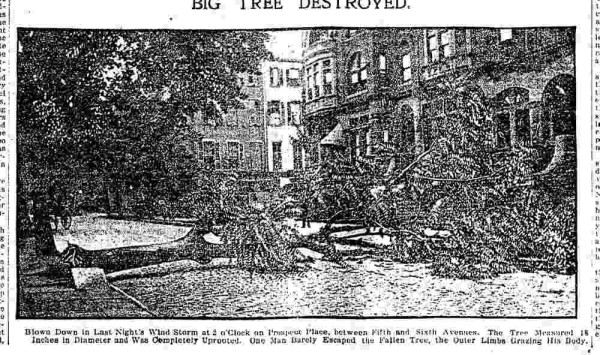
******************************************************************************************************************************** Brownstone Detectives investigates the history of our clients’ homes. The story you are about to read was composed from research conducted in the course of one of those investigations. Do you know the history of YOUR house? ******************************************************************************************************************************** On the night of July 11, 1901, Brooklyn experienced a “Wind Storm” that knocked down a number of trees. One of those fallen trees crossed Prospect Place between 5th and 6th Avenues. One man “barely escaped the fallen tree, with the outer limbs grazing his body.” The storm must not have done much damage, though, as this picture – in the Brooklyn Daily Eagle – was the only reference to it. Just a little over a week earlier, though, trees were falling faster than Brooklyn home prices in 2009, when a wind storm killed two men at Coney Island and caused extensive damage at Parkville (a suburb then just west of Kensington). “Great trees, four and five feet in circumference, were uprooted and hurled across fences and into yards where gardens were the pride of the household,” noted the Eagle. “When the strong winds swept across the open fields between Coney Island avenue and the Ocean Parkway between Franklin avenue and Avenue D,” the Eagle continued, “it carried away with it four frame cottages being erected by the Morris Construction Company.” When the skies had finally cleared, the locals would view the distruction – the suburb was “full of wreckage. Every street was full of fallen trees…” Follow @BrownstoneDetec Share ———————————————————————————————————————– […]
WHERE WAS THIS PICTURE TAKEN? (1924)
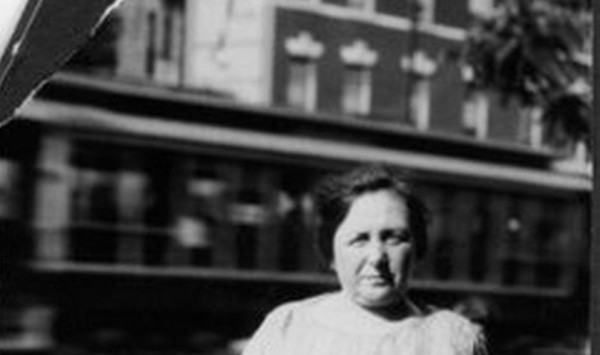
Calling all junior Brownstone Detectives! Today we have a mystery for you to solve! We invite you to come along with us as we grapple with another enigma – discerning the exact source and location of a common celluloid snapshot! EXAMINING THE EVIDENCE Have you ever come across an old family photograph and wondered when and where it was taken? You study the dog-eared snapshot and a few things immediately stand out: • A woman leans against an iron fence. • Behind her is a distinct-looking row of buildings. • A streetcar whizzes by in the background. Not much to go on, you decide, and so you think, “There must be thousands of places where this could have been taken!” And there are. But there are also many ways of whittling that list of places down and possibly even finding the exact spot where your family member (and the photographer) stood when that picture was taken. And all it really takes is a little deductive reasoning, my dear Watson! So, put on your junior Brownstone Detectives caps, set your brains to “quizzical,” and let’s go on an adventure together – through Brooklyn of the “Roaring ’20s”! ANALYZING THE CLUES First of all, we must analyze the clues we’ve listed above. Since this is a family member, we already have some background information about the woman in the picture. The woman is your great-grandmother, Sarah Bilson, and she was married to Harris Bilson. They had two kids, one of which was […]
“SWEATING” HALLOWEEN TOYS IN 1921 BROOKYLN
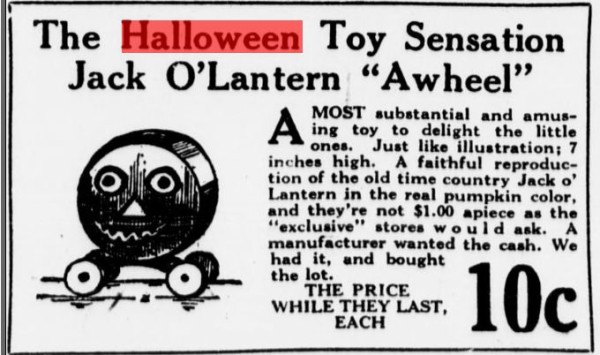
How this toy worked is quite simple, but apparently, at least according to this ad in the October 31st, 1921 edition of the New York World, it was a “most substantial and amusing toy to delight the little ones.” The ad further noted that the Halloween Toy Sensation, the Jack O’Lantern “Awheel,” was “7 inches high,” and was a “faithful reproduction of the old time country Jack o’Lantern in the real pumpkin color.” In reality it was simply a locally mass-produced means of making money off of an annual holiday. The toy was probably made of wood which was placed on a base with wheels and hand-colored by some young ladies in a sort of “sweat shop” somewhere in Brooklyn. As a seasonal item they were probably produced quickly in a carpentry shop and assembled at a rapid pace – then the girls likely learned how to hand color the “faces” as they went along. “Awheel” was an old word which meant to travel by auto or bicycle and was used in a similar fashion to “afoot.” This Jack O’Lantern, obviously, was traveling by wheel – “to the delight the little ones.” And at 10 cents a piece, it sounded like a deal. Follow @BrownstoneDetec ———————————————————————————————————————– The Brownstone Detectives This story was composed from research performed by The Brownstone Detectives. Allow us do an in-depth investigation of your house and its former owners and produce your very own House History Book. Your hardbound coffee table book will include an illustrated […]